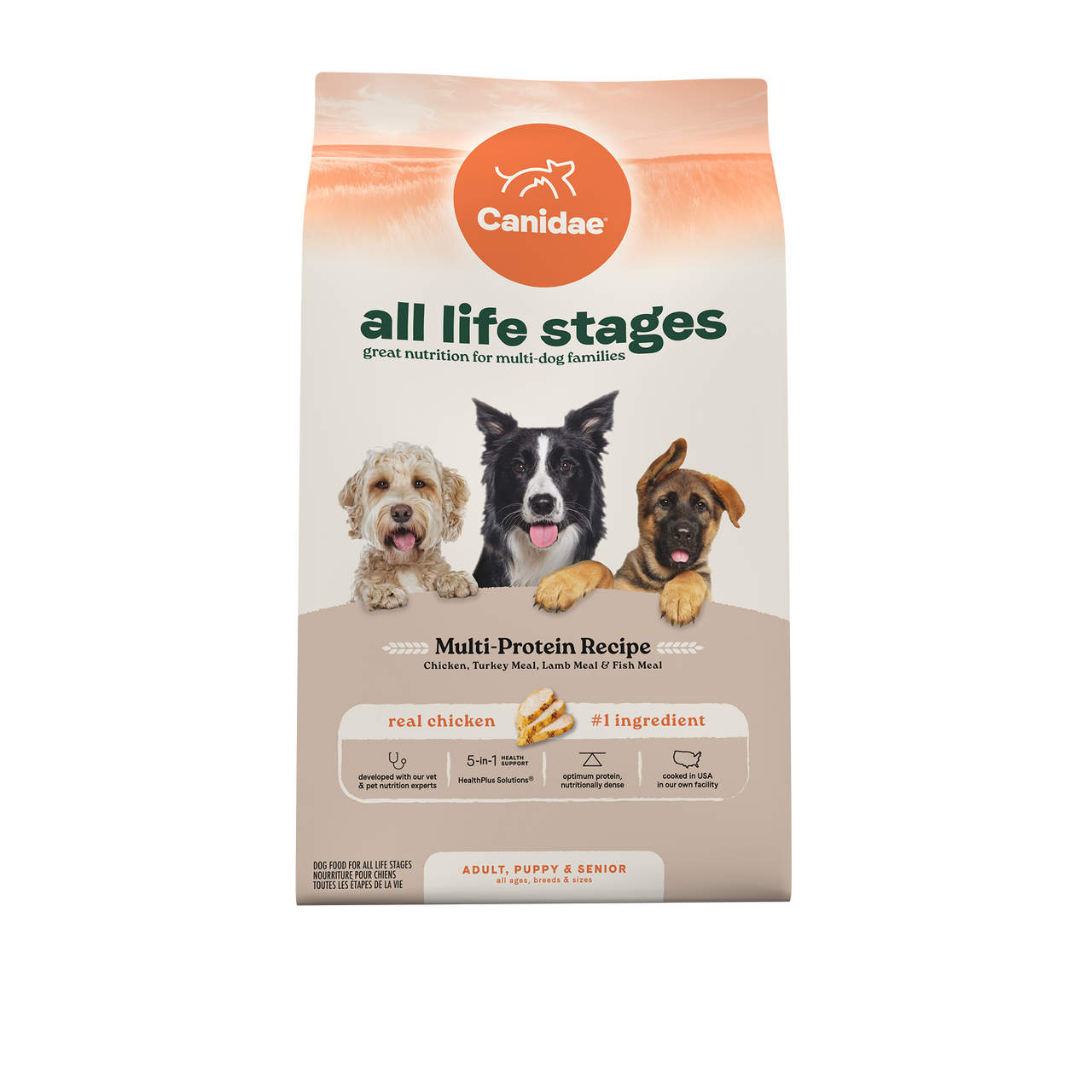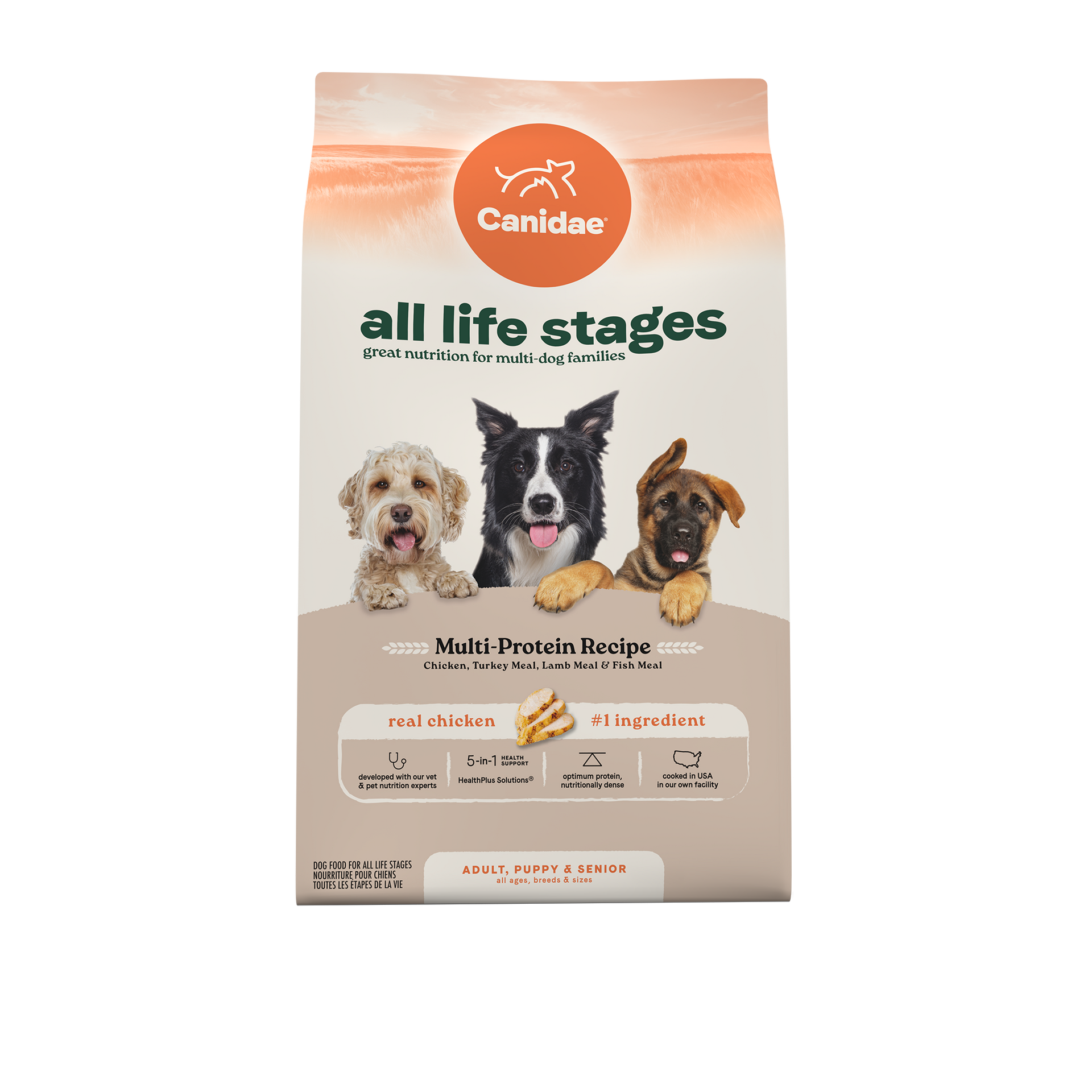
DogFoodAdvisor is reader supported See how
All reviews are 100% impartial but if you buy using links on this page, we may earn a referral fee.
Our Verdict
Canidae All Life Stages dry dog food is made up of nine recipes with ratings varying from 4.5 to 5 stars. The average rating of the whole range is 5 stars.
These vet-formulated recipes are specifically designed for dogs of all breeds, sizes and ages and are made with premium ingredients, plus added vitamins and minerals.
Pros
- Premium protein as the first ingredient
- Dedicated to transparency
- No corn, wheat or soy
Cons
- Menadione in 2 of the recipes
The table below shows each recipe in this range including our rating and the AAFCO nutrient profile: Growth (puppy), Maintenance (adult), All Life Stages, Supplemental or Unspecified.
Recipe and Label Analysis
Canidae All Life Stages Multi-Protein Recipe Chicken, Turkey Meal, Lamb Meal & Fish Meal was selected to represent the other products in the line for detailed recipe and nutrient analysis.
Canidae All Life Stages Multi-Protein Recipe Chicken, Turkey Meal, Lamb Meal & Fish Meal
Estimated Dry Matter Nutrient Content
Protein
Fat
CarbsCarbohydrates
Chicken, oatmeal, barley, whole grain sorghum, millet, peas, chicken meal (source of glucosamine and chondroitin sulfate), flaxseed, turkey meal (source of glucosamine and chondroitin sulfate), lamb meal (source of glucosamine and chondroitin sulfate), fish meal (source of glucosamine and chondroitin sulfate), rice bran, chicken fat, dried yeast, salmon oil, natural flavor, threonine, salt, potassium chloride, choline chloride, taurine, tryptophan, dl-methionine, vitamin E supplement, zinc proteinate, zinc sulfate, ferrous sulfate, l-ascorbyl-2-polyphosphate, iron proteinate, niacin supplement, mixed tocopherols (a preservative), copper sulfate, vitamin A supplement, copper proteinate, sodium selenite, manganese sulfate, manganese proteinate, thiamine mononitrate, d-calcium pantothenate, riboflavin supplement, pyridoxine hydrochloride, dried lactobacillus acidophilus fermentation product, vitamin B12 supplement, calcium iodate, folic acid, vitamin D3 supplement, biotin, dried lactobacillus casei fermentation product, dried lactobacillus plantarum fermentation product, green tea extract, rosemary extract
Fiber (estimated dry matter content) = 4.5%
Red denotes any controversial items
| Estimated Nutrient Content | |||
|---|---|---|---|
| Method | Protein | Fat | Carbs |
| Guaranteed Analysis | 24% | 10% | NA |
| Dry Matter Basis | 27% | 11% | 54% |
| Calorie Weighted Basis | 25% | 25% | 50% |
Ingredients Analysis
The first ingredient in this dog food is chicken. Chicken is considered “the clean combination of flesh and skin… derived from the parts or whole carcasses of chicken”.1
Chicken is naturally rich in the 10 essential amino acids required by a dog to sustain life.
The second ingredient is oatmeal, a whole-grain product made from coarsely ground oats. Oatmeal is naturally rich in B-vitamins, dietary fiber and can be (depending upon its level of purity) gluten-free.
The next ingredient is barley. Barley is a starchy carbohydrate supplying fiber and other healthy nutrients. However, aside from its energy content, this cereal grain is of only modest nutritional value to a dog.
The fourth ingredient is whole grain sorghum. Sorghum (milo) is a starchy cereal grain with a nutrient profile similar to corn.
Since it is gluten-free and boasts a smoother blood sugar behavior than other grains, sorghum may be considered an acceptable non-meat ingredient.
The fifth ingredient is millet, a gluten-free grain harvested from certain seed grasses. Millet is hypoallergenic and naturally rich in B-vitamins and fiber as well as other essential minerals.
The sixth ingredient includes peas. Peas are a quality source of carbohydrates. And like all legumes, they’re rich in natural fiber.
However, peas contain about 25% protein, a factor that must be considered when judging the meat content of this dog food.
The seventh ingredient is chicken meal. Chicken meal is considered a meat concentrate and contains nearly 300% more protein than fresh chicken.
The eighth ingredient is flaxseed, one of the best plant sources of healthy omega-3 fatty acids. Provided they’ve first been ground into a meal, flax seeds are also rich in soluble fiber.
However, flaxseed contains about 19% protein, a factor that must be considered when judging the actual meat content of this dog food.
The ninth ingredient is turkey meal (source of glucosamine and chondroitin sulfate), another protein-rich meat concentrate.
From here, the list goes on to include a number of other items.
But realistically, ingredients located this far down the list (other than nutritional supplements) are not likely to affect the overall rating of this Canidae product line.
With six notable exceptions…
First, we find chicken fat. Chicken fat is obtained from rendering chicken, a process similar to making soup in which the fat itself is skimmed from the surface of the liquid.
Chicken fat is high in linoleic acid, an omega-6 fatty acid essential for life. Although it doesn’t sound very appetizing, chicken fat is actually a quality ingredient.
This recipe contains, dried yeast, which can be a controversial item. Dried yeast contains about 45% protein and is rich in other healthy nutrients. Fans believe yeast repels fleas and supports the immune system. Critics argue yeast ingredients can be linked to allergies.
This may be true, but (like all allergies) only if your particular dog is allergic to the yeast itself.
What’s more, a vocal minority insist yeast can increase the risk of developing the life-threatening condition known as bloat. However, this is something we’ve not been able to scientifically verify.
In any case, unless your dog is specifically allergic to it, we feel yeast should be considered a nutritious addition.
Next, salmon oil is naturally rich in the prized EPA and DHA type of omega-3 fatty acids. These two high quality fats boast the highest bio-availability to dogs and humans.
Depending on its level of freshness and purity, salmon oil should be considered a commendable addition.
In addition, we note the inclusion of dried fermentation products in this recipe. Fermentation products are typically added as probiotics to aid with digestion.
Next, this recipe contains sodium selenite, a controversial form of the mineral selenium. Sodium selenite appears to be nutritionally inferior to the more natural source of selenium found in selenium yeast.
We also find taurine, an important amino acid associated with the healthy function of heart muscle. Although taurine is not typically considered essential in canines, some dogs have been shown to be deficient in this critical nutrient.
We view the presence of Taurine in this recipe as a positive addition
Nutrient Analysis
Based on its ingredients alone, Canidae All Life Stages Multi-Protein Recipe Chicken, Turkey Meal, Lamb Meal & Fish Meal looks like an above-average dry product.
The dashboard displays a dry matter protein reading of 27.7%, a fat level of 12% and estimated carbohydrates of about 47.5%.
As a group, the brand features an average protein content of 29.3% and a mean fat level of 14.5%. Together, these figures suggest a carbohydrate content of 43.3% for the overall product line.
And a fat-to-protein ratio of about 49%.
Which means this Canidae product line contains…
Near-average protein. Below-average fat. And above-average carbs when compared to a typical dry dog food.
Canidae Dog Food Recall History
The following automated list (if present) includes all dog food recalls related to Canidae through December 2025.
You can view a complete list of all dog food recalls since 2009 here.
Our Rating of Canidae All Life Stages Dog Food
Canidae All Life Stages is a dry dog food range that is certainly worthy of the 5 stars the brand has earned in our review. The products are made from premium and sustainable ingredients and are vet-formulated.
About
Canidae was founded in 1996 by Scott Whipple and John Gordon, who met while working at a local pet store.
In 2012, Canidae acquired a manufacturing facility in Brownwood, Texas. Called Ethos, it’s one of the smallest pet food plants in the US, the company controls every step of manufacturing. It’s also a research and development center equipped with a lab that tests all incoming ingredients and outgoing products.
Compare Canidae All Life Stages Dog Food
How does Canidae All Life Stages compare with The Dog Food Advisor's most recommended brands?
A Final Word
The Dog Food Advisor does not accept money, gifts, samples or other incentives in exchange for special consideration in preparing our reviews.
However, we do receive a referral fee from online retailers (like Chewy or Amazon) and from sellers of perishable pet food when readers click over to their websites from ours. This helps cover the cost of operation of our free blog. Thanks for your support.
For more information, please visit our Disclaimer and Disclosure page.








